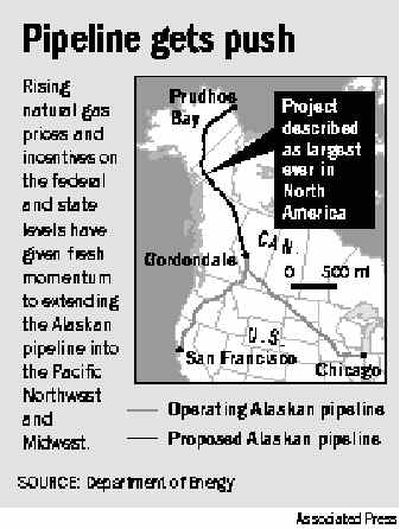Natural gas pipeline inches toward reality

WASHINGTON – A 3,500-mile pipeline to deliver natural gas from Alaska’s North Slope to the fuel-hungry Midwest is suddenly more than a pipe dream.
Congress has promised to cover 80 percent of the cost if the project goes bust – and Alaska is thinking about owning part of it.
But despite a tripling in natural gas prices in the last few years, the companies that own the gas remain skittish about rushing into a $20 billion investment. And how much government help should be given has become an issue in a highly contested Senate campaign in Alaska.
To ease investors’ concerns, Alaska Gov. Frank Murkowski is proposing to make the state part owner of the pipeline. His administration is expected to announce a state proposal this week, prompting charges by Democrats that Murkowski was rushing the issue to help his daughter’s Senate campaign.
Murkowski denied politics was involved in the planned announcement.
“I didn’t create the timing,” he told reporters. The state’s chief negotiator said he wanted a state proposal completed by the end of October so a final agreement with the private companies could be completed for legislative action in January.
In a rush of pre-election business, Congress gave the Alaska pipeline fresh momentum by promising loan guarantees for 80 percent of the pipeline’s cost, and gave developers other tax breaks as well as promises of less burdensome permitting requirements.
“After working for more than 20 years … we have finally taken steps to make the Alaska natural gas pipeline happen,” Sen. Ted Stevens, R-Alaska, said after Congress agreed to the incentive package.
The incentives were touted as a major breakthrough by Alaska’s other senator, Lisa Murkowski, but quickly became fodder in her closely contested election race. Her opponent, Democratic former Gov. Tony Knowles, criticized her for failing to get a better incentive package, including gas price supports, to further ease pipeline developers’ concerns.
Tax credits if Alaska gas fell below a certain price had been sought by the Alaska senators and some of the potential pipeline investors, but were strongly opposed by the Bush administration as being unfair to gas producers in the lower 48 states.
The companies that own the Alaska gas – ExxonMobil Corp., ConocoPhillips and BP PLC – have praised Congress’ action, but remain reluctant to push headlong into a $20 billion investment. They are seeking more advantages and security from the state to mitigate their risk in what has been described as the largest private construction project ever in North America. If given the go-ahead the pipeline would take 10 years to plan and construct.
Alaska’s North Slope is believed to hold as much as 100 trillion cubic feet of natural gas, the largest reserves in North America. That includes more than 30 trillion cubic feet easily accessible in the Prudhoe Bay area, where for years gas has been pumped along with oil and then injected back into the ground to help force up more oil.
Rising demand for the fuel has brought renewed focus on trying to get some of that gas to U.S. markets. A pipeline would provide 4.5 billion cubic feet of gas a day by 2014 at the earliest, or about 7 percent of current consumption.
The pipeline would run from Prudhoe Bay along the route of the trans-Alaska oil pipeline to Fairbanks, then follow the Alaska Highway into Canada, where it eventually would connect with pipelines in Alberta and a system of lines into the Midwest, as far as Chicago, and into the Pacific Northwest.